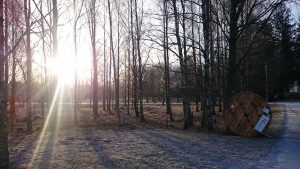Vuonna 2005 Suomen yliopistolainsäädäntöön lisättiin niin sanottu kolmas tehtävä. Tämä vaikuttavuuden vaatimus muotoiltiin laissa vuorovaikutukseksi ympäröivän yhteiskunnan kanssa, jolla tulee edistää elinikäistä oppimista sekä tutkimustulosten että taiteellisen toiminnan vaikuttavuutta. Vaikka terminä kolmas tehtävä on osin harhaanjohtava, on vaikuttavuus yksi keskeisimmistä tavoitteista esimerkiksi tutkimus- ja innovaationeuvoston viimeisimmissä linjauksissa (TIN 2014). Korkeakoulujärjestelmän radikaalin kehittämisen ohella kaksi tärkeintä linjausta ovat tutkimus- ja innovaatiotoiminnan tulosten hyödyntäminen ja vaikuttavuuden edistäminen sekä uusien kasvulähteiden, aineettoman pääoman ja yritystoiminnan vahvistaminen. Nämä linjaukset antavat signaalin siitä, miten vaikuttavuus mielletään. Tutkimuksen tulee tukea taloudellista kasvua ja yritystoimintaa.
Aihetta on viime aikoina sivunnut myös Tuomas Aivelo Kaiken takana on loinen –blogissaan, jossa hän kiinnittää huomiota hallituksen niin sanottuun lippulaivaohjelmaan. Lippulaiva-tutkimuskeskittymien tavoitteena on tutkimuksen yhteiskunnallinen ja taloudellinen vaikuttavuus. Lippulaiva-termi on tutkimuksen kansainvälistymisen työryhmän antia, mutta työryhmän linjauksissa tutkimuksen vaikuttavuus rinnastuu taloudelliseen kasvuun: ”Huippuluokan osaamista tarvitaan, jotta Suomessa voi syntyä uusia innovatiivisia ja menestyviä yrityksiä.” (OKM 2017, 23). Se, että pohdintaa yhteiskunnallisen vaikuttavuuden eri muodoista ja ulottuvuuksista ei käydä, vinouttaa ymmärrystä siitä, mitä tutkimuksen tekeminen pitää sisällään ja minkälaisiin yhteiskunnallisiin kehityskulkuihin tai ongelmiin tutkijat pyrkivät työllään vastaamaan.
Tutkimuksen arviointimalleissa ovat viime aikoina korostuneet vuorovaikutukselliset prosessit. Suuntaus itsessään on perusteltu etenkin kun ajatellaan aloja, joissa vuorovaikutuksen mekanismit liittyvät paikallisiin yhteistoimintamuotoihin sekä sosiaalisten tai yhteiskunnallisten ilmiöiden ymmärtämiseen ilman ensisijaista kaupallista motiivia. Suomessa tällainen ala on esimerkiksi oppimisvaikeuksien tutkimus, joka on kytkeytynyt vahvasti koulujärjestelmän kehittymiseen. Kun suurin osa ikäluokasta osallistui opetukseen, huomattiin, että kaikki eivät koulun vaatimuksista selviä. Nykyään oppimisvaikeuden diagnosointi vaatii sen, että oppilas on saanut riittävän määrän tukiopetusta. Koulusta tulee vaatimustason nousun kautta myös ehdollistava ja altistava tekijä. Näin oppimisvaikeuksilla on sekä kieleen että kouluihin oppimisympäristöinä liittyvä vahva kulttuurinen luonne.
Mitä enemmän ilmiöistä, kuten oppimisvaikeuksista, tiedetään, sitä enemmän niitä myös kategorisoidaan. Tutkijaa voivat kiinnostaa ilmiön synty ja esiintyminen sekä se, miten oppimisvaikeuksia voidaan ennustaa, mutta kysymys kuuluu myös mitä asialle halutaan tehdä. Alan tutkijat, joita olen seurannut väitöskirjassani, näkevät työnsä osana hyvinvointivaltion perinnettä: heidän kehittämänsä diagnostiset menetelmät, oppimismateriaalit ja kuntoutusvälineet halutaan lasten käyttöön mahdollisimman aikaisessa vaiheessa ja maksutta. Koska Suomessa tilanne on hyvä ja oppimisen vaikeuksiin pystytään puuttumaan osana neuvola- ja koulujärjestelmää, ovat tutkijat siirtäneet katseensa globaalille tasolle. Viemällä tutkimukseen perustuvaa oppimispeliä Afrikkaan tutkimusryhmän tavoitteena on lukutaidon lisääminen maailmanlaajuisesti.
Suomessa verovaroin tuettu tutkimus on tutkijoiden mielestä luonnollisesti yhteiskunnan eri toimijoiden käytössä. Näyttäisi siltä, että myös ulkomaille suunnatuissa hankkeissa tutkijat ovat luottaneet enemmän niin sanottuihin perinteisiin vuorovaikutusmuotoihin työssään kuin innostuneet kaupallisten ratkaisujen luomisesta. Tutkijat mainitsivat ristiriidan ns. tuoteajattelun ja tutkimuksen välillä. He kokivat, että heidän työllään on vaikutusta nimenomaan jos sitä ei ”paketoida tuotteeksi”. Tämä ”paketoiminen” tarkoitti heille sitä, että tutkimustyö pysähtyisi, vaikka se ei ole heidän mielestään tutkimuksen luonne. Tutkimusryhmän johtajan mukaan ei ole olemassa tietoa oppimisesta, joka pysähtyisi johonkin pisteeseen, vaan tieto elää jatkuvasti.
Oppimisvaikeuksien tutkimus on esimerkki siitä, miten tutkimuksen yhteiskunnalliset motiivit yhdistyvät tieteen sisäisiin tavoitteisiin ja vuorottelevat näiden kanssa. Lisäksi tutkimusmenetelmien ja –välineiden muovautuminen tutkimuksen edetessä mahdollistaa tutkimuksen tekemisen sekä aineiston keruun uusilla tavoilla. Ymmärryksen lisääminen oppimisvaikeuksista ilmiönä on ollut tutkijoiden työn perusta, johon on vahvasti kuulunut soveltaminen sekä ongelmiin puuttuminen. Puhuminen kolmannesta tehtävästä tutkimuksen ja opetuksen rinnalla irrottaa tutkimuksen vaikuttavuuden helposti omaksi alueekseen, vaikka lähtökohtaisesti tiede ja tutkimus ovat yhteiskunnallista toimintaa ja tutkimuksen motiivit ovat usein yhteiskunnalliseen ongelmanratkaisuun pyrkiviä.
Tässä valossa hallituksen uudet lippulaiva-kaavailut eivät tunnu kovin innovatiivisilta. Niissä ei oteta kantaa vaikuttavuuden muihin kuin taloudellisiin ulottuvuuksiin, puhumattakaan siitä, että keskustelua heräteltäisiin laajemmalti siitä halutaanko julkisella tutkimusrahoituksella mahdollisesti edistää demokratian, terveyden, tasavertaisuuden tai palvelujen saatavuuden arvoja.
Terhi Esko
tohtorikoulutettava, Helsingin yliopisto
Lähteet:
TIN (2014): Uudistava Suomi: tutkimus- ja innovaatiopolitiikan suunta 2015 – 2020. Tutkimus- ja innovaationeuvosto.
OKM (2017): Yhteistyössä maailman parasta. Korkeakoulutuksen ja tutkimuksen kansainvälisyyden edistämisen linjaukset 2017–2025. Opetus- ja kulttuuriministeriön julkaisuja 2017:11
http://julkaisut.valtioneuvosto.fi/bitstream/handle/10024/79438/okm11.pdf?sequence=3

